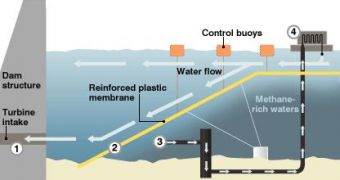Methane is a greenhouse effect gas 20 times more powerful than CO2.
Fortunately, the emission of methane is reduced compared to that of CO2; but even so, its emissions are on a boom, due to human activity.
Now a Brazilian team at National Space Research Institute (INPE) has found a way to cut off methane emission from hydro-electric dams, a main source of this gas, by capturing and burning it.
The methane-produced energy could supplement the energy delivered by the dam turbines.
There is a long-running debate on how clean the hydro-electric power really is: in tropical areas of Brazil, dams deliver over 90% of the electricity, but they emit huge methane amounts that boost global warming as much as carbon the dioxide expelled by a similar power station burning fossil fuels.
Methane is a bacterial by-product when the microbes degrade organic matter in anaerobic (no oxygen) conditions, like the bottom of lakes and reservoirs.
The intake pipes for hydroelectric turbines are usually located quite deep, thus the methane-rich water is suddenly exposed to open air from high-pressure. "It's like opening a bottle of soda. A large part of the methane is dissolved in the water bubbles, and it's released to the atmosphere. That's the reason big hydro-electric dams built in tropical areas are harmful to the environment", said lead researcher Fernando Ramos, to BBC's Science In Action program.
Of course, the methane release of each dam is linked to its water vegetation amount, the temperature, the reservoir shape and other factors. However, large dams could damp annually worldwide methane amounts with the effects of some 800 million tones of carbon dioxide.
UK's 2006 carbon dioxide emissions were roughly 660 million tones.
With the new technology, some tropical dams with heavy methane load could raise their production by up to 50%. The first stage impedes deep, methane-rich water from going directly into the turbines, decreasing the "soda bottle" effect. An underwater membrane or steel barrier would channel methane-poor surface water to the intake pipes. A floating device would pump methane-loaded deep water to an enclosed rotor at the surface.
The released methane would be piped to a plant that would burn the gas for electricity production.
The methane burning does produce carbon dioxide, but this carbon was originally absorbed from the air by plants through photosynthesis before entering the sediments that produced the methane under bacterial action, thus there's no additional greenhouse gas released to the atmosphere, not to mention the more powerful effect of the methane on the global warming.
The methane production involves energy consume, that's why this could be at night when the demand is much lower; anyhow, the thermal plants would produce much more energy.
Prototype equipment will be ready by 2008. "We cannot hide from this problem; you have to address it. In fact, it's better to recognize there is a problem today, and to use this methane that is there as a commodity, harvest it to produce energy. And most important, it will reduce the pressure for building new dams in sensitive areas like the Amazon region", said Ramos.

 14 DAY TRIAL //
14 DAY TRIAL //